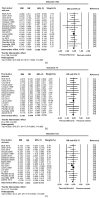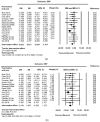Impact of Flavonols on Cardiometabolic Biomarkers: A Meta-Analysis of Randomized Controlled Human Trials to Explore the Role of Inter-Individual Variability
- PMID: 28208791
- PMCID: PMC5331548
- DOI: 10.3390/nu9020117
Impact of Flavonols on Cardiometabolic Biomarkers: A Meta-Analysis of Randomized Controlled Human Trials to Explore the Role of Inter-Individual Variability
Abstract
Several epidemiological studies have linked flavonols with decreased risk of cardiovascular disease (CVD). However, some heterogeneity in the individual physiological responses to the consumption of these compounds has been identified. This meta-analysis aimed to study the effect of flavonol supplementation on biomarkers of CVD risk such as, blood lipids, blood pressure and plasma glucose, as well as factors affecting their inter-individual variability. Data from 18 human randomized controlled trials were pooled and the effect was estimated using fixed or random effects meta-analysis model and reported as difference in means (DM). Variability in the response of blood lipids to supplementation with flavonols was assessed by stratifying various population subgroups: age, sex, country, and health status. Results showed significant reductions in total cholesterol (DM = -0.10 mmol/L; 95% CI: -0.20, -0.01), LDL cholesterol (DM = -0.14 mmol/L; Nutrients 2017, 9, 117 2 of 21 95% CI: -0.21, 0.07), and triacylglycerol (DM = -0.10 mmol/L; 95% CI: -0.18, 0.03), and a significant increase in HDL cholesterol (DM = 0.05 mmol/L; 95% CI: 0.02, 0.07). A significant reduction was also observed in fasting plasma glucose (DM = -0.18 mmol/L; 95%CI: -0.29, -0.08), and in blood pressure (SBP: DM = -4.84 mmHg; 95% CI: -5.64, -4.04; DBP: DM = -3.32 mmHg; 95% CI: -4.09, -2.55). Subgroup analysis showed a more pronounced effect of flavonol intake in participants from Asian countries and in participants with diagnosed disease or dyslipidemia, compared to healthy and normal baseline values. In conclusion, flavonol consumption improved biomarkers of CVD risk, however, country of origin and health status may influence the effect of flavonol intake on blood lipid levels.
Keywords: flavonols; Interindividual variability; cardiovascular disease; meta‐analysis; quercetin; systematic review; blood lipids; blood pressure; glucose.
Conflict of interest statement
The authors declare no conflict of interest.
Figures





Similar articles
-
Omega-6 fats for the primary and secondary prevention of cardiovascular disease.Cochrane Database Syst Rev. 2018 Jul 18;7(7):CD011094. doi: 10.1002/14651858.CD011094.pub3. Cochrane Database Syst Rev. 2018. Update in: Cochrane Database Syst Rev. 2018 Nov 29;11:CD011094. doi: 10.1002/14651858.CD011094.pub4. PMID: 30019765 Free PMC article. Updated.
-
Mobile phone-based interventions for improving adherence to medication prescribed for the primary prevention of cardiovascular disease in adults.Cochrane Database Syst Rev. 2018 Jun 22;6(6):CD012675. doi: 10.1002/14651858.CD012675.pub2. Cochrane Database Syst Rev. 2018. Update in: Cochrane Database Syst Rev. 2021 Mar 26;3:CD012675. doi: 10.1002/14651858.CD012675.pub3. PMID: 29932455 Free PMC article. Updated.
-
A systematic review and meta-analysis of randomized controlled trials of the effect of konjac glucomannan, a viscous soluble fiber, on LDL cholesterol and the new lipid targets non-HDL cholesterol and apolipoprotein B.Am J Clin Nutr. 2017 May;105(5):1239-1247. doi: 10.3945/ajcn.116.142158. Epub 2017 Mar 29. Am J Clin Nutr. 2017. PMID: 28356275
-
Effect of cocoa on blood pressure.Cochrane Database Syst Rev. 2017 Apr 25;4(4):CD008893. doi: 10.1002/14651858.CD008893.pub3. Cochrane Database Syst Rev. 2017. PMID: 28439881 Free PMC article.
-
Fixed-dose combination therapy for the prevention of atherosclerotic cardiovascular diseases.Cochrane Database Syst Rev. 2017 Mar 6;3(3):CD009868. doi: 10.1002/14651858.CD009868.pub3. Cochrane Database Syst Rev. 2017. PMID: 28263370 Free PMC article.
Cited by
-
The Possible Role of Nutraceuticals in the Prevention of Cardiovascular Disease.High Blood Press Cardiovasc Prev. 2019 Apr;26(2):101-111. doi: 10.1007/s40292-019-00309-5. Epub 2019 Feb 27. High Blood Press Cardiovasc Prev. 2019. PMID: 30811011 Review.
-
Role of Dietary Antioxidants in the Preservation of Vascular Function and the Modulation of Health and Disease.Front Cardiovasc Med. 2017 Nov 1;4:64. doi: 10.3389/fcvm.2017.00064. eCollection 2017. Front Cardiovasc Med. 2017. PMID: 29164133 Free PMC article. Review.
-
Plant Polyphenols as Heart's Best Friends: From Health Properties, to Cellular Effects, to Molecular Mechanisms of Action.Int J Mol Sci. 2025 Jan 22;26(3):915. doi: 10.3390/ijms26030915. Int J Mol Sci. 2025. PMID: 39940685 Free PMC article. Review.
-
Quercetin as a Therapeutic Product: Evaluation of Its Pharmacological Action and Clinical Applications-A Review.Pharmaceuticals (Basel). 2023 Nov 20;16(11):1631. doi: 10.3390/ph16111631. Pharmaceuticals (Basel). 2023. PMID: 38004496 Free PMC article. Review.
-
Impact of Foods and Dietary Supplements Containing Hydroxycinnamic Acids on Cardiometabolic Biomarkers: A Systematic Review to Explore Inter-Individual Variability.Nutrients. 2019 Aug 5;11(8):1805. doi: 10.3390/nu11081805. Nutrients. 2019. PMID: 31387247 Free PMC article.
References
-
- Go A.S., Mozaffarian D., Roger V.L., Benjamin E.J., Berry J.D., Borden W.B., Bravata D.M., Dai S., Ford E.S., Fox C.S., et al. Heart disease and stroke statistics—2013 update: A report from the american heart association. Circulation. 2013;127:e6–e245. doi: 10.1161/CIR.0b013e31828124ad. - DOI - PMC - PubMed
-
- Perk J., De Backer G., Gohlke H., Graham I., Reiner Ž., Verschuren M., Albus C., Benlian P., Boysen G., Cifkova R., et al. European guidelines on cardiovascular disease prevention in clinical practice (version 2012) Eur. Heart J. 2012;33:1635–1701. doi: 10.1016/j.atherosclerosis.2012.05.007. - DOI - PubMed
-
- Stone N.J., Robinson J., Lichtenstein A.H., Merz C.N.B., Blum C.B., Eckel R.H., Goldberg A.C., Gordon D., Levy D., Lloyd-Jones D.M., et al. 2013 ACC/AHA guideline on the treatment of blood cholesterol to reduce atherosclerotic cardiovascular risk in adults: A report of the American College of Cardiology/American Heart Association task force on practice guidelines. Circulation. 2013 doi: 10.1161/01.cir.0000437738.63853.7a. - DOI - PubMed
Publication types
MeSH terms
Substances
LinkOut - more resources
Full Text Sources
Other Literature Sources
Medical

